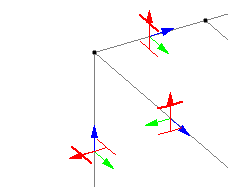GS. Coordinates in STAAD.Pro
STAAD.Pro Physical Modeler uses a conventional Cartesian coordinate system, with the global Y axis assumed as vertical (i.e., "Y up", or the height of the structure is parallel to the global Y axis).
Global Coordinate System
This coordinate system is a rectangular coordinate system (X, Y, Z) which follows the orthogonal "right hand" rule. This coordinate system may be used to define the joint locations and loading directions. The translational degrees of freedom are denoted by u1, u2, & u3 and the rotational degrees of freedom are denoted by u4, u5, & u6.
Local Coordinates
Each member or surface has its own local Cartesian coordinate system which is also oriented using the "right hand" rule.
The longitudinal axis of a member is the first axis, with the positive axis taken from the i to the j ends (i.e, Ni and Nj). The second axis is the oriented such that the 1-2 plane is then parallel to the global Y axis. The third axis is then normal to the first and second local axes as defined by the right hand rule. The local 2 and 3 axes coincide with the two principle moments of inertia of the cross-section. In the special case of a vertical member (where the local 1 axis is parallel to the global Y axis; i.e., a column), the local 3 axis is then made parallel to the global Z axis and the 2 axis is oriented respectively.
For surfaces, the local x axis is aligned with the edge defined by the first two nodes of the surface (i.e., N1 and N2). The program then calculates the area of each triangle formed by any other nodes to determine the largest area. This triangle determines the plane of the surface and the local y axis lies perpendicular to the x axis within this plane. The third axis is then orthogonal to the surface as defined by the "right hand" rule.






